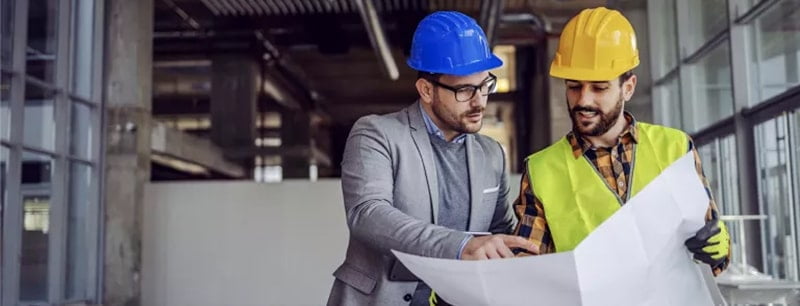
Owners Representative versus Contractor
In the atmosphere of the construction industry, you may have heard of many different titles; two of which consist of an owner’s representative and a general contractor. They may sound very similar but the two titles serve as different roles for a reason.
Both of these roles serve an essential purpose in the concrete repair process to ensure construction projects are finalized. In this article, we will be discussing the two roles, how they are different, how they are similar, and how each navigates their own role in the construction industry and process for concrete construction and repairs.
What is an owner’s representative?
An owner’s representative serves as the individual seeking to accomplish the goals for the property owner or property management company. They handle a significant number of different tasks to make sure all of the needs of the owner are being met during the construction project. When hiring an owner’s representative, as a property manager or owner, you are looking to assign and delegate the majority of the tasks and responsibilities onto the representative. By alleviating those responsibilities, you are allowing the representative to manage the construction project for you. A representative who has a significant amount of knowledge in the field will be able to effectively manage your construction project with ease.
The owner’s representative essentially serves as the liaison with a multitude of parties involved for a construction project. However, they serve a critical role in ensuring the construction project is completed with success and ease. They are there to make sure your project is completed on the proper timeline, stays within the proposed budget, and are accomplishing all of the goals you have set forth.
What is a General Contractor?
The general contractor for a construction project is the manager ensuring the project is finalized. Now this sounds very similar to an owner’s representative, doesn’t it? It is very similar but the owner’s representative is assigned to seek the best interests for the building owner or manager. The general contractor is more so responsible for the day-to-day operations for the construction project.
The general contractor plays a managerial role in ensuring the project runs smoothly. They are at the construction site ensuring the ordering of materials, supervising the work of any subcontractors, making sure the progress of the construction project is on the appropriate track.
How are their responsibilities different?
For any construction repairs, the general contractor will be responsible for the actual work and is the operations manager ensuring that the construction project is on track. Their responsibility is to ensure all tasks are completed by all parties involved. They’ll typically be at the construction site overseeing every aspect of the construction plans and making sure the project is within the timeframe and budget. Among these tasks, they are also responsible for ensuring safety precautions are being made and complying with the appropriate regulations and building codes.
The owner’s representative focuses on the owner’s interests for the project which includes reducing unnecessary costs and ensuring all charges made for a project is for work already completed. They also differentiate between a general contractor because they’re out on the construction site to serve your best and financial interests. If any problems arise, a general contractor it is your responsibility to resolve those problems; however, as an owner’s representative, they look to present all options for your building helping you make a logical and thoughtful decision.
How do their relationships differ?
As a general contractor, it is your responsibility to ensure the project is completed. You are responsible for the execution of the construction project and all of the work involved as outlined in the contract. A general contractor will typically have extensive experience and knowledge in the construction industry; whereas, an owner’s representative may not necessarily need that expertise. The general contractor is in charge of managing all logistical aspects of the project, managing the financial budgets, all parties involved in the project, the scheduling of the project, and much more.
An owner’s representative is serving the interests of the property owner or manager. They’re looking to accomplish their goals versus the general contractor or any other subcontractors. Oftentimes, the owner’s representative does not have any requirements to abide by any contract set forth by the general contractor or any other parties part of the construction project. Their objective is to ensure the building owner’s interests and goals are accomplished with the construction renovation.
On-site presence
When it comes to daily operations, it’s the general contractor that’s responsible for such tasks. They will typically be at the construction site every day ensuring that progress is continuously being made for the project and resolving any issues that may arise. They’re also responsible for coordinating all of the tasks with all of the subcontractors such as those installing plumbing, flooring, roofing, windows, and doors. The general contractor’s physical presence is a critical one because it ensures that work is being made for the construction project and it ensures any obstacles can be resolved within a timely manner. Since the majority of their time is spent solving problems, it is a crucial fact that they must be present to resolve any issues within a timely fashion. They will also reallocate resources and employees to accomplish certain tasks as part of the project when needed. At times, certain tasks will require a deadline to be accomplished; therefore, being very flexible and adaptable is a key factor in a competent general contractor.
The owner’s representative won’t typically be present daily at the construction site. They will typically visit the construction site routinely to ensure that the construction project is maintaining progress and is on the right track. An owner’s representative takes on a more broader role than a general contractor; they contain first hand insights into the progress of the project and seek to ensure alignment with the owner’s goals is being made. They will typically visit the site to assess the status of the project, review the quality of work being performed, and behave as a liaison for the building owner or manager for any issues they may have regarding the construction project. It may appear as if they are doing less work compared to a general contractor; however, this is not the case. Both serve different purposes and look to accomplish different goals. The owner’s representative is still monitoring the progress, quality, and goals of the project to ensure the property owner or manager is obtaining the level of work they were promised in the construction contract. Ultimately, they are to protect the interests of the building owner.
Project Oversight
So, how are general contractors and owner representatives similar? Well, they essentially perform the same function: ensure the construction project is executed but each has their own set of goals and responsibilities. They’re very similar because they’re both managing the progress of the project, addressing issues and obstacles as they arise, and engaging in communication with all parties involved.
In summary, both the general contractor and the owner’s representative are responsible for project oversight, albeit from different perspectives. While the general contractor focuses on managing day-to-day construction activities, the owner’s representative ensures that the project aligns with the owner’s vision and objectives and that contractual obligations are fulfilled. Together, they work collaboratively to oversee all aspects of the construction project and ensure its successful completion.
Budget and Schedule Management
Furthermore, managing a budget and a schedule for a construction project can be a very complicated process. However, both of these are functions that both a general contractor and owner’s representative have to accomplish. The general contractor is responsible for managing all of the construction costs and managing it in a manner that is in alignment with the agreed upon construction schedule and contract. The owner’s representative is also responsible for the same tasks; however, the only minor difference is they’re also monitoring it to ensure it’s in line with the construction contract.
Taking this into account, both roles are aligned and they work together to ensure the project is completed within the specific budget and timeline agreed upon. They both collaborate very closely during the pre planning phase to develop a plan which ensures the budget and schedule aligns with the estimated scope of the construction project. Throughout the life cycle of the project, they will both monitor the progress and adjust accordingly when needed. Regarding the schedule, during the planning phase of the construction project, a plan will be devised to ensure key milestones and deadlines are met. The progress is measured against the schedule and they are looking for any potential delays and how they can work together to avoid or resolve them in a timely manner.
General contractors and owner’s representatives collaborate to address issues and create solutions related to the proposed budget and schedule. They identify the issues, find answers, and implement the solutions to overcome any obstacles and keep the project on the right track of progress. Ultimately, both the general contractor and the owner’s representative are focused on delivering a successful project that exceeds the client’s expectations. They prioritize customer satisfaction by managing resources, allocating said resources and employees where needed, following timelines, and delivering high-quality results.
In summary, while the general contractor and the owner’s representative have unique roles and responsibilities, they share common goals and work together closely in managing budgets and schedules to ensure the successful completion of construction projects. Their relationship is essential for optimizing project outcomes and delivering value to clients.
Communication, Coordination, and Collaboration
In any role, effective communication is a required skill to ensure all expectations are met. This is no different in the construction industry where you have multiple parties working together to ensure the successful completion of a construction project. Effective communication is required to ensure a smooth flow of progress for both parties, the owner’s representative and the general contractor. Both parties are utilizing these skills and serve as central points of contact for the property owner or manager. They are also coordinating and collaborating with all the parties involved such as architects, engineers, subcontractors, and any stakeholders to ensure the progress of the construction project.
FINAL ANALYSIS
In the intricate tapestry of construction projects, the roles of general contractors and owner’s representatives are distinct yet complementary. While the general contractor focuses on the physical execution of the project, the owner’s representative acts as the owner’s advocate, ensuring that their interests and objectives are safeguarded throughout the project lifecycle. By understanding the differences and similarities between these roles, stakeholders can leverage their expertise synergistically to navigate the complexities of construction endeavors effectively and achieve successful project outcomes.





